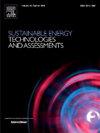采用季节性灰水处理的可持续建筑混合可再生能源系统的优化尺寸
IF 7.1
2区 工程技术
Q1 ENERGY & FUELS
Sustainable Energy Technologies and Assessments
Pub Date : 2025-04-01
DOI:10.1016/j.seta.2025.104287
引用次数: 0
摘要
本研究介绍了一种创新的方法来优化可持续家庭的混合可再生能源系统(HRES)的规模。该系统集成了光伏板、风力涡轮机和备用电池,实现了接近于零的负载损失概率(LLP),同时解决了通过电凝处理灰水的能量和存储要求。与仅关注能源产生和储存的传统分级方法不同,拟议的双重目的优化将来自适当大小的可再生能源的剩余发电量与灰水处理的能源需求相结合,确保处理过程仅在剩余电力可用时运行。这种统一的优化方法消除了对废水处理的额外能源基础设施的需求。收集的灰水的水箱容积经过优化,可防止春夏秋三季的溢流,以确保完全的灰水经过处理,可安全地用于灌溉和冲洗。根据土耳其eski本文章由计算机程序翻译,如有差异,请以英文原文为准。

Optimized sizing of hybrid renewable energy systems for sustainable buildings with seasonal grey water treatment
This study introduces an innovative approach to the optimized sizing of hybrid renewable energy systems (HRES) for sustainable households. The system integrates photovoltaic panels, wind turbines, and backup batteries to achieve near-zero loss of load probability (LLP) while concurrently addressing energy and storage requirements for grey water treatment through electrocoagulation. Unlike conventional sizing methodologies that focus solely on energy generation and storage, the proposed dual-purpose optimization aligns the surplus electricity generation from correctly sized renewable sources with the energy requirements for grey water treatment, ensuring that the treatment process operates only when excess power is available. This unified optimization approach eliminates the need for additional energy infrastructure for wastewater treatment. The tank volume for the collected grey water is optimized to prevent overflow during the spring, summer, and fall seasons to ensure complete grey water is treatment that can be safely used for irrigation and flushing. Extensive simulations, validated against empirical data from Eskişehir, Turkey, demonstrate that the proposed system effectively balances energy generation and treatment demands, ensuring minimal infrastructure costs and reliable operation throughout seasonal variations while integrating the two separate sustainability goals.
求助全文
通过发布文献求助,成功后即可免费获取论文全文。
去求助
来源期刊

Sustainable Energy Technologies and Assessments
Energy-Renewable Energy, Sustainability and the Environment
CiteScore
12.70
自引率
12.50%
发文量
1091
期刊介绍:
Encouraging a transition to a sustainable energy future is imperative for our world. Technologies that enable this shift in various sectors like transportation, heating, and power systems are of utmost importance. Sustainable Energy Technologies and Assessments welcomes papers focusing on a range of aspects and levels of technological advancements in energy generation and utilization. The aim is to reduce the negative environmental impact associated with energy production and consumption, spanning from laboratory experiments to real-world applications in the commercial sector.
 求助内容:
求助内容: 应助结果提醒方式:
应助结果提醒方式:


